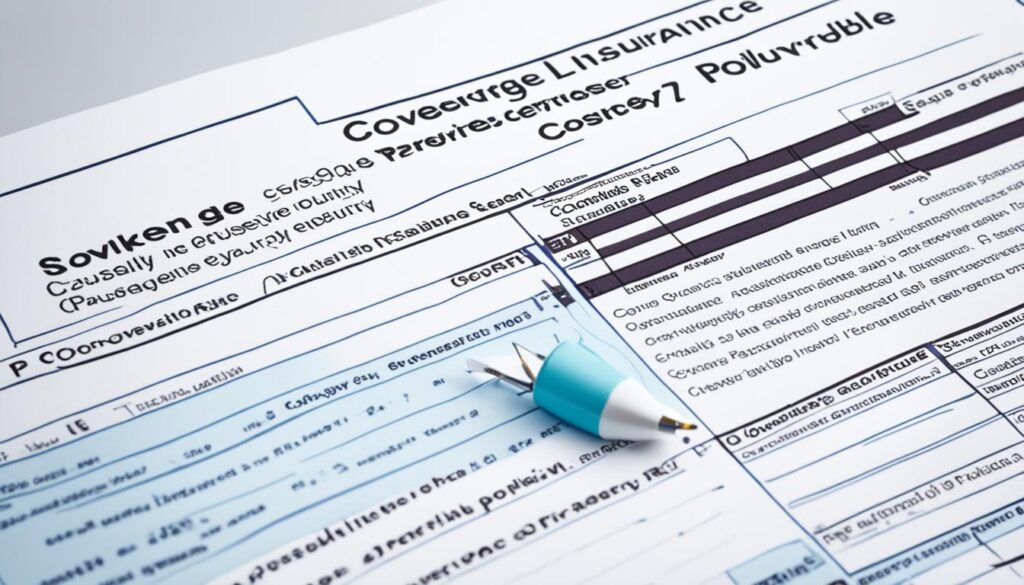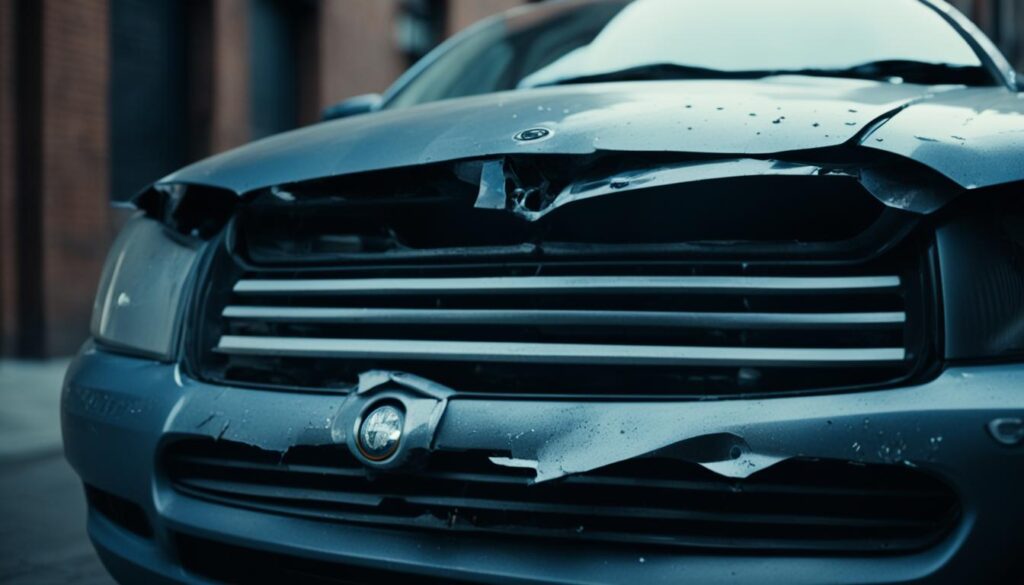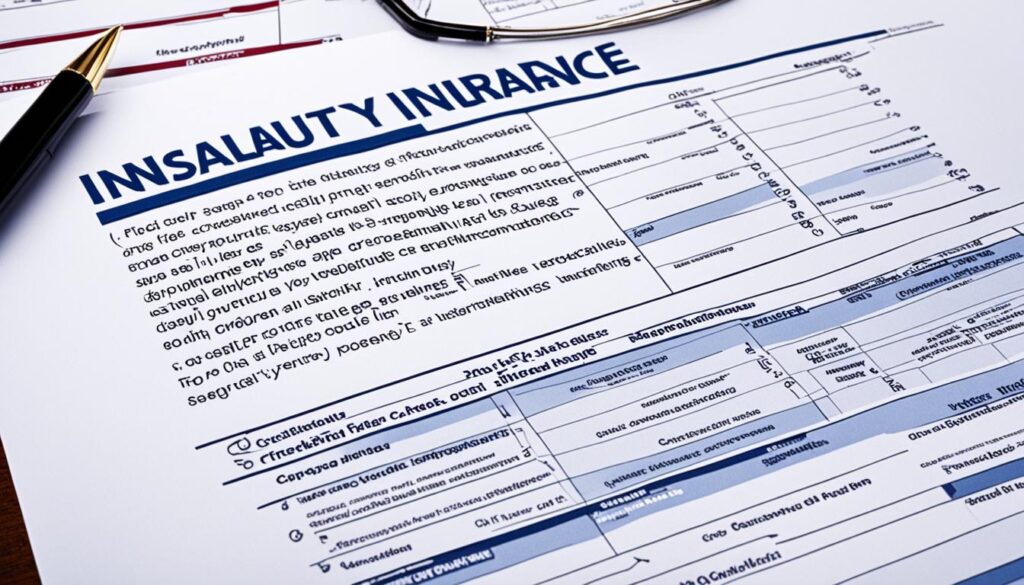Welcome to our article series on casualty insurance policies, where we’ll explore the different components and coverage options that make up these essential insurance policies. Whether you’re an individual looking for personal protection or a business owner safeguarding your assets, understanding the key components of casualty insurance is crucial for managing risks effectively.
In this first section, we’ll provide an overview of the key components that make up a typical casualty insurance policy. From liability coverage to property protection, we’ll delve into the essential elements that ensure comprehensive financial security.
Key Takeaways:
- Casualty insurance policies are designed to provide financial protection against liability and property damage.
- Understanding the key components of a casualty insurance policy is important for individuals and businesses alike.
- Liability coverage, property coverage, auto insurance, and homeowner’s insurance are all integral parts of a comprehensive casualty insurance policy.
- Policy limits and coverage details can vary, so it’s important to review and understand the terms of your specific policy.
- By comprehending the key components of a casualty insurance policy, you can make informed decisions to manage risk and secure appropriate coverage.
Understanding Casualty Insurance Policies
Casualty insurance policies play a vital role in safeguarding individuals and businesses against financial risks arising from liability and property damage. In this section, we will provide a comprehensive overview of casualty insurance, exploring the different types of coverage available and highlighting its significance in providing financial protection.
What is Casualty Insurance?
Casualty insurance refers to a type of insurance policy that offers financial protection against liability for injuries to others or damage to their property. It covers a wide range of risks, including bodily injury, property damage, professional negligence, and legal costs associated with lawsuits.
The Types of Casualty Insurance Policies
There are various types of casualty insurance policies tailored to meet different needs. Some common types include:
- General Liability Insurance: Provides coverage for accidents or injuries that occur on your property or as a result of your business operations.
- Professional Liability Insurance: Protects professionals against claims of negligence or errors in the performance of their duties.
- Product Liability Insurance: Covers manufacturers or sellers for damages caused by defective products.
- Commercial Auto Insurance: Offers protection for vehicles used for business purposes, including company-owned cars, trucks, or vans.
- Workers’ Compensation Insurance: Provides benefits to employees who suffer work-related injuries or illnesses.
Understanding the different types of casualty insurance policies is crucial for selecting the right coverage that aligns with your specific needs.
The Importance of Casualty Insurance
Casualty insurance offers essential financial protection for both individuals and businesses. It helps mitigate the risk of substantial financial loss resulting from unforeseen accidents, lawsuits, or property damage. By having a comprehensive casualty insurance policy in place, you can have peace of mind knowing that you are protected against potential liabilities and can minimize the financial impact of unexpected events.
As you can see, casualty insurance is a critical component of risk management. It provides individuals and businesses with the necessary coverage to handle unforeseen circumstances that may lead to significant financial consequences. In the next section, we will delve into the specifics of liability coverage within casualty insurance policies.
Liability Coverage in Casualty Insurance Policies
Liability coverage is a critical component of casualty insurance policies that protects individuals and businesses from legal costs and claims for bodily injury or property damage. It provides the necessary financial protection against unforeseen events that may result in liability or legal liability, ensuring peace of mind and safeguarding assets.
Liability insurance, also known as general liability insurance or personal liability insurance, is designed to cover the costs associated with legal claims made against the policyholder due to their negligence or unintentional actions that resulted in harm to others or damage to their property. This coverage helps individuals and businesses minimize the financial burden of legal expenses, medical bills, and compensation for bodily injuries or property damage.
When a liability insurance policy is in place, it typically includes:
- Liability coverage limits: The maximum amount the insurance company will pay for a covered claim.
- Liability protection for bodily injury: Coverage for medical expenses, lost wages, and legal fees resulting from injuries caused to others due to the policyholder’s negligence.
- Liability protection for property damage: Coverage for the repair or replacement costs of property belonging to others that was unintentionally damaged by the policyholder.
Liability insurance policies can vary in terms of coverage limits and specific protections offered. Common liability insurance policies include general liability insurance, professional liability insurance, product liability insurance, and employer’s liability insurance, among others. Each type of insurance focuses on different areas of liability and provides specific coverage tailored to the needs of different industries or professions.
Types of Liability Coverage in Casualty Insurance
Liability coverage in casualty insurance policies can be categorized into various types, including:
- General Liability Insurance: Provides coverage for bodily injury, property damage, and personal or advertising injury liabilities that may arise from the operations of a business or the actions of individuals.
- Professional Liability Insurance: Specifically designed for professionals who provide services, such as doctors, lawyers, architects, or consultants, to protect against claims of negligence, errors, or omissions in their professional duties.
- Product Liability Insurance: Protects businesses that manufacture, distribute, or sell products against claims for bodily injury or property damage caused by their products.
- Employer’s Liability Insurance: Offers coverage for legal liabilities arising from injuries or illnesses suffered by employees in the course of their employment.
Having liability coverage ensures that individuals and businesses can focus on their core activities without the constant worry of financial repercussions due to liability claims. It provides a safety net in the event of unforeseen circumstances, allowing for necessary compensation, legal defense, and potentially saving from bankruptcy.

| Types of Coverage | Description |
|---|---|
| General Liability Insurance | Covers bodily injury, property damage, and personal or advertising injury liabilities. |
| Professional Liability Insurance | Protects professionals against claims of negligence, errors, or omissions. |
| Product Liability Insurance | Protects businesses against claims for bodily injury or property damage caused by their products. |
| Employer’s Liability Insurance | Covers legal liabilities arising from injuries or illnesses suffered by employees. |
Property Coverage in Casualty Insurance Policies
Property coverage is a vital component of casualty insurance policies. It provides financial protection against damage to property caused by covered perils. Whether it’s your home, rental property, or business premises, property insurance ensures that you have the necessary coverage to repair or replace damaged property, minimizing potential financial loss.
Property insurance and casualty insurance often go hand in hand, as casualty insurance policies typically include property coverage alongside liability coverage. This comprehensive approach ensures that policyholders are safeguarded against a range of risks, including both damage to property and liability incidents.
There are different types of property coverage available within casualty insurance policies, each designed to address specific needs and risks. Here are some common types of property coverage:
- Homeowners Insurance: This type of coverage protects homeowners from property damage and liability incidents that occur on their property.
- Renters Insurance: Renters can obtain insurance to cover personal belongings and provide liability protection in the event of damages or injuries caused by the renter.
- Commercial Property Insurance: Businesses can secure this coverage to protect their physical assets, including buildings, equipment, and inventory, from damage or loss.
Property and casualty coverage also extends to coverage for other types of properties, such as vacant properties, condos, and mobile homes, ensuring comprehensive protection for a wide range of individuals and businesses.
Insuring your property is essential for protecting your financial investment. Property coverage offers peace of mind by providing the necessary resources to repair or replace your property if it suffers damage due to covered perils.
When considering property insurance, it’s important to review the specifics of your policy, including coverage limits, deductibles, and any exclusions or limitations. Understanding the terms and conditions of your policy will help you make informed decisions and ensure that you have adequate coverage in the event of property damage.
To illustrate a clearer understanding of property coverage in casualty insurance, here is an example scenario:
| Scenario | Property Damage Coverage |
|---|---|
| A tree falls on your house during a severe storm, causing significant damage to the roof and interior. | The property insurance component of your casualty insurance policy would typically cover the cost of repairs or replacements, helping restore your home to its pre-damage condition. |
Property coverage in casualty insurance policies plays a crucial role in protecting your assets and providing financial security in the face of unexpected property damage. It is worth considering property insurance as an essential part of your overall risk management strategy.

Auto Insurance in Casualty Insurance Policies
Auto insurance plays a crucial role in casualty insurance policies, providing essential protection for vehicle owners and drivers. Whether you own a car, motorcycle, or any other motor vehicle, having adequate auto insurance coverage is vital for financial security and peace of mind.
Car insurance, also known as auto insurance or vehicle insurance, safeguards you against various risks, including accidents, theft, and damage to your vehicle. It offers financial support to cover repair costs, medical expenses, and even legal expenses in case of liability claims resulting from an auto accident.
One key aspect of auto insurance coverage within casualty insurance policies is uninsured motorist coverage. This type of coverage protects you in the unfortunate event of an accident caused by an uninsured or underinsured driver. If the other party involved does not have enough insurance to cover the damages, uninsured motorist coverage can step in to provide the necessary financial assistance.
When it comes to auto insurance, there are different types of coverage options available with varying degrees of protection. Here are some common types:
- Bodily injury liability coverage: This type of coverage helps pay for medical expenses, lost wages, and legal costs if you injure someone else in an accident.
- Property damage liability coverage: This coverage helps pay for repairs or replacement of property belonging to others that was damaged in an accident caused by you.
- Comprehensive coverage: Comprehensive coverage protects against non-collision related incidents, such as theft, vandalism, and natural disasters.
- Collision coverage: Collision coverage provides financial protection for repairs or replacement of your vehicle in case of a collision with another vehicle or object.
- Medical payments coverage: Medical payments coverage helps pay for medical expenses for you and your passengers, regardless of who is at fault in an accident.
Having comprehensive auto insurance coverage is vital to protect yourself, your vehicle, and your finances in the event of an accident or unexpected damage. It ensures that you are not left paying hefty repair bills or medical expenses out of pocket.
In addition to the various coverage options, auto insurance within casualty insurance policies also takes into account factors such as the driver’s age, driving history, and the type of vehicle being insured to determine the premium rates. It’s essential to compare quotes from multiple insurance providers to find the right coverage at a competitive price.
Now, let’s take a look at an example to understand how auto insurance in casualty insurance policies works:
| Scenario | Auto Insurance Coverage |
|---|---|
| Car Accident with Property Damage | Property damage liability coverage: $50,000 |
| Car Accident with Injury | Bodily injury liability coverage: $100,000 per person, $300,000 per accident Medical payments coverage: $5,000 |
| Uninsured Driver Causes an Accident | Uninsured motorist coverage: $100,000 per person, $300,000 per accident |
Note: The above table is for illustrative purposes only and coverage amounts may vary based on the policy and insurance provider.
As seen in the example, auto insurance coverage within casualty insurance provides essential financial protection in various accident scenarios. It ensures that you are adequately covered for any damages or injuries resulting from an auto accident, whether caused by you or an uninsured driver.
Next, we will explore another component of casualty insurance policies – homeowner’s insurance – which offers protection for your home and personal belongings.

Homeowner’s Insurance in Casualty Insurance Policies
When it comes to protecting your home and personal belongings, homeowner’s insurance plays a crucial role. As a component of casualty insurance policies, homeowner’s insurance provides comprehensive coverage against property damage and liability incidents that may occur at your residence.
Having homeowner’s insurance gives you peace of mind, knowing that you are financially protected in case of unforeseen events such as fires, thefts, or accidents on your property. It not only covers the structure of your home but also extends to your personal belongings and offers liability protection.
With homeowner’s insurance, you can rest assured that your dwelling, including its foundation, walls, roof, and fixtures, will be covered if damaged by covered perils, such as fire, storms, or vandalism. Additionally, the insurance policy typically includes coverage for detached structures, such as garages, sheds, or fences.
Moreover, homeowner’s insurance safeguards your personal belongings, including furniture, appliances, electronics, clothing, and more. If your possessions are damaged or destroyed due to covered perils or stolen, you can file a claim to recover their value, providing you with the financial means to replace or repair them.
Premium Determination
The premiums for homeowner’s insurance policies are based on several factors, including the value of your property, location, construction materials, and overall risk. Insurance providers consider the replacement cost of your home and personal belongings when determining the premium. For example, a larger home or a home in an area prone to natural disasters may result in higher premiums.
It’s crucial to ensure that your homeowner’s insurance policy is sufficient to cover the cost of rebuilding your home and replacing your personal belongings in the event of a loss.
Homeowner’s insurance policies also offer liability coverage, protecting you if someone gets injured on your property or if you cause damage to someone else’s property. This coverage can help cover medical expenses, legal fees, and other costs associated with such incidents.
It’s important to review your homeowner’s insurance policy periodically to ensure that it aligns with your current needs. As life circumstances change, such as renovations, acquiring expensive items, or changes in your property’s value, you may need to update your policy to maintain adequate coverage.
Here’s an example of how homeowner’s insurance may come into play:
Example Scenario:
During a severe storm, a lightning strike causes a fire at your home. The fire damages the structure, including the roof and interior. Your personal belongings, such as furniture, electronics, and artwork, are also destroyed by the fire and ensuing smoke damage. In this case, your homeowner’s insurance policy would provide coverage to repair or rebuild your home and replace your damaged personal property.
Image:

Summary Table: Homeowner’s Insurance Coverage
| Coverage | Description |
|---|---|
| Dwelling Coverage | Covers the structure of your home and its attached fixtures against covered perils such as fire, theft, or vandalism. |
| Personal Property Coverage | Protects your personal belongings, including furniture, appliances, electronics, and clothing, against covered perils and theft. |
| Liability Coverage | Provides protection if someone is injured on your property or if you cause damage to someone else’s property, covering medical expenses, legal fees, and other associated costs. |
| Additional Living Expenses Coverage | Covers the costs of temporary accommodation, meals, and other necessary expenses if your home becomes uninhabitable due to a covered loss. |
Having homeowner’s insurance as part of your casualty insurance policy is essential for homeowners. It safeguards your investment, belongings, and personal liability, providing comprehensive coverage and financial protection. Whether it’s repairing your home after a disaster or replacing stolen personal belongings, homeowner’s insurance ensures that you can rebuild and recover without bearing the full financial burden.
Understanding Policy Limits and Coverage in Casualty Insurance
When it comes to casualty insurance, understanding policy limits and coverage is crucial for ensuring adequate protection. Policy limits refer to the maximum amount an insurance company will pay for covered losses, liability claims, or property damage. These limits vary depending on the type of insurance coverage and the specific policy.
It’s important to review your insurance policy to determine the coverage limit—that is, the maximum amount your insurance policy will pay out for a particular incident or claim. This limit may apply to bodily injury, property damage, or a combination of both.
Insurance coverage, on the other hand, refers to the specific incidents, accidents, or events that your insurance policy protects against. Understanding what your insurance policy covers is essential to ensure you have the necessary financial protection in case of an unforeseen situation.
Insurance coverage can vary depending on the type of casualty insurance you have. For example, a liability insurance policy may cover costs related to bodily injury or property damage resulting from accidents for which you are found legally liable. On the other hand, property insurance coverage may protect against damage to your property caused by covered perils, such as fire or theft.
It’s important to note that insurance coverage may not cover all types of incidents or damages. Policies often include exclusions and limitations that define the extent of coverage. It’s crucial to carefully review your policy and understand the limits of your coverage.
Insurance companies may also offer optional coverage endorsements that can provide additional protection beyond the standard policy limits. These endorsements allow you to customize your coverage to meet your specific needs.
Ultimately, understanding the policy limits and coverage of your casualty insurance policy is essential for ensuring you have the appropriate protection in place. Reviewing your policy thoroughly, including the coverage limitations and any optional endorsements, will help you make informed decisions about your insurance needs.
Perhaps this visual representation will help illustrate how policy limits and coverage work in casualty insurance:

| Policy Type | Coverage Limit | Insurance Coverage |
|---|---|---|
| Liability Insurance | $1 million per occurrence | Provides coverage for bodily injury and property damage claims where you are found legally liable. |
| Property Insurance | $500,000 | Protects against damage to your property caused by covered perils, such as fire, theft, or natural disasters. |
| Auto Insurance | Varies depending on policy | Covers vehicle damage, liability, and medical expenses resulting from an auto accident. |
How Casualty Insurance Works: Examples and Coverage Scenarios
Understanding how casualty insurance works can be best illustrated through real-life examples and coverage scenarios. Here, we will explore different situations where casualty insurance provides liability protection and covers damage to another’s property or injury. These examples will help you grasp the practical application of casualty insurance and how it can safeguard your financial well-being.
Example 1: Auto Accident
Imagine you are involved in a car accident where you are at fault, resulting in damage to the other party’s vehicle and bodily injury. In this scenario, casualty insurance can step in to provide liability coverage, taking care of the repair costs for the other person’s vehicle and covering their medical expenses. This protects you from expensive out-of-pocket expenses and potential lawsuits.
For example, if you have comprehensive and collision coverage under your auto insurance policy, casualty insurance may cover the damage to the other person’s vehicle. Additionally, if you have bodily injury liability coverage, it can help address the medical expenses of the injured party.
Example 2: Property Damage
Let’s say a storm causes a tree on your property to fall onto your neighbor’s house, causing significant damage. In this case, casualty insurance can step in to cover the cost of repairs to your neighbor’s property. This ensures that you’re financially protected from the expenses associated with the damage caused to another person’s property.
If you have property insurance and casualty coverage, your casualty insurance may cover the expenses related to the repair or reconstruction of your neighbor’s house. This provides you with the assurance that you won’t have to bear the financial burden of the damage caused by the falling tree.
These examples demonstrate how casualty insurance not only provides liability protection but also covers the costs associated with the damage to another’s property or injuries. It serves as a crucial safety net, offering financial support and peace of mind in unforeseen circumstances.
By understanding the practical scenarios in which casualty insurance can come into play, you can make informed decisions when selecting your insurance coverage. Remember, having the appropriate casualty insurance safeguards you from potential financial hardships resulting from liability claims or property damage.
Additional Types of Casualty Insurance
In addition to the commonly mentioned types of casualty insurance, there are several other varieties that offer specialized coverage to meet specific needs. Let’s explore some of these additional types:
1. Theft Insurance
Theft insurance provides coverage against the loss or damage of property due to theft, burglary, or robbery. It offers financial protection in case of stolen goods, stolen identities, or property damage resulting from theft-related incidents.
2. Compensation Insurance
Compensation insurance, also known as workers’ compensation or workers’ comp insurance, provides coverage for the medical expenses, lost wages, and rehabilitation costs for employees who are injured or become ill as a result of their work. It helps employers fulfill their legal obligations and protects employees in case of work-related accidents or illnesses.
3. Commercial General Liability Insurance
Commercial general liability (CGL) insurance provides coverage for businesses against bodily injury, property damage, and personal injury claims resulting from their operations, products, or services. This essential coverage helps protect businesses from potential financial losses arising from legal claims and lawsuits.
4. Property and Casualty Insurance Policies
Property and casualty (P&C) insurance policies provide a comprehensive package that includes coverage for both property and liability risks. These policies offer protection against damage to property and liability incidents, such as bodily injury or property damage caused by covered perils. They are commonly used by businesses to safeguard their assets and manage their risks effectively.
Also Read:- Top Car Insurance in California: Find the Best
By considering these additional types of casualty insurance, individuals and businesses can tailor their insurance coverage to their specific needs, ensuring comprehensive protection against a wide range of risks and unexpected events.
Conclusion
In conclusion, casualty insurance policies provide essential financial protection against liability and property damage. Whether you are an individual or a business owner, understanding the key components and types of coverage available is crucial for effective risk management. By making informed decisions and securing the necessary insurance, you can safeguard your assets and ensure your financial well-being.
Casualty insurance offers comprehensive coverage for various risks, including liability incidents and property damage caused by covered perils. It gives you the peace of mind knowing that you are protected against unforeseen events that could result in significant financial losses. With liability coverage, you are shielded from legal costs and claims for bodily injury or property damage, while property coverage safeguards your belongings against damage or loss.
By carefully assessing your insurance needs and working with a trusted insurance provider, you can tailor your casualty insurance policy to suit your specific requirements. This proactive approach to risk management enables you to mitigate potential financial risks and protect your financial interests. Remember, financial protection is not merely a safety net; it is a strategic tool that allows you to navigate uncertainties with confidence.
FAQs
What are the key components of a casualty insurance policy?
The key components of a casualty insurance policy typically include liability coverage, property coverage, and additional types of coverage depending on the specific policy. These components provide financial protection against liability for bodily injury or property damage and cover losses related to property damage or theft.
What is casualty insurance?
Casualty insurance is a broad term that refers to insurance policies designed to provide financial protection against liability for bodily injury or property damage. It includes both property insurance, which covers losses related to property damage or theft, and liability insurance, which covers legal costs and claims for bodily injury or property damage caused by the insured party’s negligence.
What types of casualty insurance are available?
There are many different types of casualty insurance policies available, including auto insurance, homeowner’s insurance, renters insurance, commercial general liability insurance, and various property and casualty insurance policies tailored to specific industries. Each type of insurance provides coverage for different risks and can be customized based on individual or business needs.
What does liability coverage in casualty insurance policies entail?
Liability coverage in casualty insurance policies offers financial protection against legal costs and claims for bodily injury or property damage caused by the insured party’s negligence. It includes bodily injury liability coverage, which pays for medical bills, lost wages, and other expenses incurred by individuals injured by the insured, as well as property damage liability coverage, which covers damage to another person’s property caused by the insured party.
How does property coverage work in casualty insurance policies?
Property coverage in casualty insurance policies protects against losses related to property damage or theft. It can cover damage to your own property, such as your home or belongings, as well as provide compensation if someone is injured on your property. Property coverage typically includes coverage for damage caused by covered perils, such as fire, theft, or vandalism.
What role does auto insurance play in casualty insurance policies?
Auto insurance is a vital component of casualty insurance policies, covering damage to your vehicle, liability for bodily injury or property damage caused by an accident, and other related expenses. It includes various types of coverage, such as liability coverage, uninsured/underinsured motorist coverage, and collision/comprehensive coverage, providing financial protection in the event of an auto accident or damage to your vehicle.
How does homeowner’s insurance fit into casualty insurance policies?
Homeowner’s insurance is an essential part of casualty insurance policies, providing coverage for your home and personal belongings. It protects against property damage, such as fire or theft, and offers personal liability coverage if someone is injured on your property. A homeowner’s insurance policy may also include additional coverage for other structures on your property and additional living expenses if your home becomes uninhabitable.
What are policy limits and why are they important in casualty insurance?
Policy limits refer to the maximum amount of coverage provided by an insurance policy. They can include both coverage limits for liability and property damage. It is important to understand the limits of your policy to ensure you have adequate coverage in the event of a claim or loss. If an incident exceeds the policy limits, you may be responsible for paying any remaining costs out of pocket.
Can you provide an example of how casualty insurance may cover liability and property damage?
Certainly! Let’s say you’re a homeowner, and a guest slips and falls down the stairs in your home, resulting in injuries. With casualty insurance, your liability coverage could help pay for the injured guest’s medical bills, rehabilitation costs, and any potential legal fees if they decide to file a lawsuit. Additionally, if the staircase is damaged during the fall, your casualty insurance may cover the repair or replacement costs for the property damage.
Are there any additional types of casualty insurance beyond the commonly mentioned ones?
Yes, there are additional types of casualty insurance that may be relevant depending on your specific needs or industry. Some examples include theft insurance, which covers losses due to theft or burglary, compensation insurance, which provides coverage for work-related injuries or illnesses, and commercial general liability insurance, which offers liability protection for businesses. There are also various property and casualty insurance policies tailored to specific industries, such as construction or healthcare.




